Last updated: March 30, 2023
Article
Wright Brothers National Memorial: Site of the First Controlled Powered Flight (Teaching with Historic Places)

(National Park Service)
Success four flights Thursday morning all against twenty one mile wind started from level with engine power alone average speed through air thirty one miles longest 57 seconds inform press home Christmas.
In this matter-of-fact telegram, Wilbur and Orville Wright unceremoniously announced to their family a stunning achievement--the world's first controlled powered flight. They awoke on December 17, 1903, to freezing temperatures, rain puddles covered in ice, and winds up to 27 mph. Although the winds had not diminished by 10:00 a.m., the brothers decided not to wait any longer to test their flying machine. The unsteady, 12-second, 120-foot flight that followed effectively launched the aviation age.
It was no accident that North Carolina's remote Outer Banks provided the setting for this historic occasion. Careful research had brought the Wright brothers to the Kitty Hawk area in September 1900 to test their first full-size glider. The conditions seemed ideal for flight experiments: strong winds, tall sand dunes for launching, wide expanses of sandy beaches for soft landings, and isolation for privacy. Their success on December 17, 1903 represented the culmination of four years of painstaking research and trials in which they designed and improved their flying machines at home in Dayton, Ohio, and tested them each year near Kitty Hawk. The site where the brothers launched their gliders and eventually flew a powered aircraft is preserved today as Wright Brothers National Memorial.
About This Lesson
This lesson is based on National Park Service materials, including the National Register of HIstoric Places file on the Wright Brothers National Memorial (with photographs), and other sources related to the Wright brothers. The lesson plan was sponsored by the National Historic Landmarks Program as part of its Aviation Heritage theme study. This study was conducted in partnership with the United States Air Force Academy through a Cooperative Agreement with the organization of American Historians. The lesson plan was written by Brenda K. Olio, former Teaching with Historic Places staff member. The lesson was edited by staff at the Wright Brothers National Memorial and the Teaching with Historic Places program. This lesson is one in a series that brings the important stories of historic places into classrooms across the country.
Where it fits into the curriculum
Topics: This lesson could be used in American history, social studies, and geography courses in units on technological and scientific advances at the turn of the 20th century, aviation history, or great inventors. It also could be used in a unit commemorating the anniversary of the Wright brothers' first flight on December 17, 1903.
Time period: Early 20th century
Objectives for students
1) To describe the status of human flight experiments at the turn of the 20th century.
2) To determine why the Wright brothers chose the Outer Banks of North Carolina to conduct their flight experiments and how conditions in this region impacted their efforts.
3) To describe the challenges faced by the Wright brothers during their flight experiments and how they overcame them to achieve controlled powered flight on December 17, 1903.
4) To examine how the Wright brothers' historic accomplishments at Kill Devil Hills, North Carolina have been commemorated.
5) To research efforts to commemorate important people and events in their own community.
Materials for students
The materials listed below either can be used directly on the computer or can be printed out, photocopied, and distributed to students. The maps and images appear twice: in a smaller, low-resolution version with associated questions and alone in a larger version.
1) two maps showing the Outer Banks of North Carolina;
2) three readings about the Wright brothers' quest to achieve controlled powered flight;
3) an excerpt from Orville Wright's December 17, 1903, diary entry;
4) seven photos of the Wright brothers' gliders, the 1903 Flyer, their camp at Kill Devil Hills, and the site today.
Visiting the site
Wright Brothers National Memorial, administered by the National Park Service, is located in the town of Kill Devil Hills on the Outer Banks of North Carolina. The park's entrance is between mileposts 7 and 8 on U.S. 158, about midway between Kitty Hawk and Nags Head. The park is open daily during the summer from 9:00 a.m. to 6:00 p.m., and 9:00 a.m. to 5:00 p.m. the rest of the year. The park is closed December 25. For more information, contact the Superintendent, Cape Hatteras Group, 1401 National Park Drive, Manteo, North Carolina, 27954 or visit the park's web site.
Getting Started
Inquiry Question
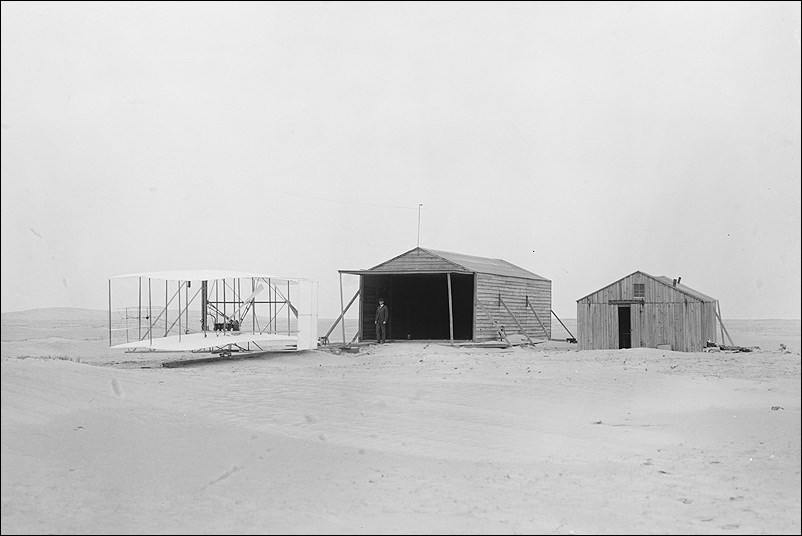
Library of Congress, Prints and Photographs Division, LC-DIG-ppprs-00607)
What do you think is depicted in this photograph?
When might it have been taken?
Setting the Stage
As myths, legends, and actual experiments attest, mankind always has been fascinated with the idea of flying. Dreams of soaring like the birds inspired many throughout the ages to construct human "wings" or other flying contraptions, but these failed dismally. Beginning in the 1780s, hot-air balloons successfully carried passengers, but these lighter-than-air vehicles merely drifted with the wind. Finally, in the 19th century, a few experimenters made some progress towards inventing a heavier-than-air flying machine. After so many failed attempts, however, many concluded that the effort was a waste of time. Undaunted by the odds, two brothers from Ohio took up the quest that had eluded mankind for thousands of years.
Growing up in Dayton, Ohio, Wilbur Wright (1867-1912) and his younger brother Orville (1871-1948) displayed mechanical ability and an aptitude for experimenting. Their initial interest in flight began in 1878 when their father gave them a toy helicopter activated by a twisted rubber band. Fascinated by the toy, the brothers built several versions of it. As a teenager, Orville Wright started his own printing business using a printing press he and Wilbur made out of spare parts. By 1889, Wilbur had joined him in the business. In 1892 they turned their attention to cycling and opened the Wright Cycle Company. The brothers sold and repaired bicycles and then began producing their own line of bikes. Their expertise as bike mechanics proved instrumental in solving the problem of human flight.
Wilbur and Orville's interest in flight resurfaced in 1896 when they read of the glider accident that killed Otto Lilienthal, a German gliding pioneer. After studying the subject, the Wrights concluded that the key to flying was devising a system to control a flying machine in the air. They also decided that they must learn to fly an unpowered glider before piloting a machine with an engine.
By the fall of 1900, the Wrights had designed their first full-size glider and were ready to test it. They needed a place with steady winds of 15 to 20 mph, hills for launching, soft areas for landing, and isolation for privacy. Research indicated that Kitty Hawk, on the Outer Banks of North Carolina, met these criteria. The Wrights traveled from Dayton, Ohio, to the Outer Banks several weeks each year between September 1900 and December 1903 to conduct their flight experiments.
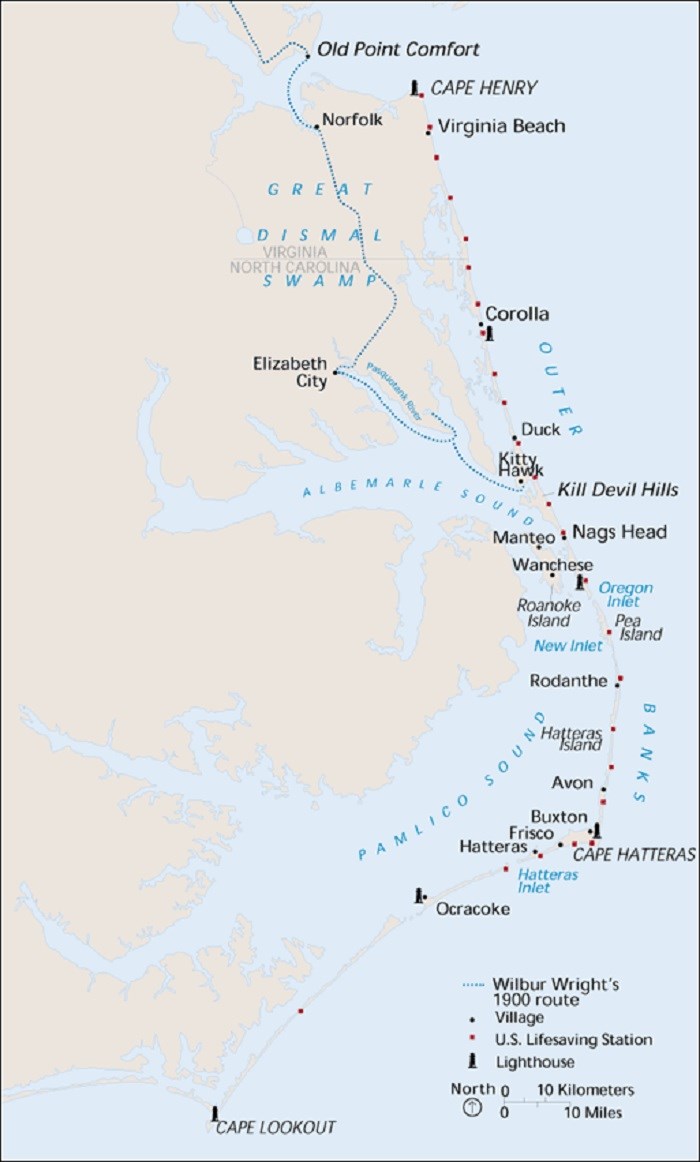
(National Park Service)
The Outer Banks are a narrow chain of barrier islands stretching more than 175 miles along North Carolina's coast. Separated from the mainland by sounds up to 30 miles wide, the area is subject to severe storms and high winds. At the time the Wrights were looking for a site for their experiments, Kitty Hawk consisted of a few houses, a post office, a U.S. Lifesaving station to aid shipwreck victims, and a U.S. Weather Bureau station. According to Weather Bureau records obtained by the Wrights, Kitty Hawk was the sixth-windiest station in the country. After receiving assurance from local residents that the surrounding area offered wide flat beaches, tall sand dunes, and privacy, the brothers decided that this would be the best place to test their glider.
Wilbur left Dayton, Ohio, on September 6, 1900, with some basic supplies and crates containing parts of the glider. He traveled by train to Old Point Comfort, Virginia, and then took a steamer to Norfolk. From there he boarded a train to Elizabeth City, North Carolina, and finally a small fishing boat to Kitty Hawk. That first journey took seven days. Orville joined Wilbur after finding someone to look after the bicycle shop.
Questions for Map 1
1. Using an atlas in your classroom or school library, locate Dayton, Ohio, and Kitty Hawk, North Carolina on a map of the United States. How would you describe the location of each? How did the Wright brothers decide to test their glider on the Outer Banks?
2. Describe Wilbur Wright's first trip from Dayton to Kitty Hawk. Based on Map 1, why do you think there were so many "legs" on the journey? Why didn't the brothers travel together?
Locating the Site
Map 2: Kitty Hawk and Kill Devil Hills area.
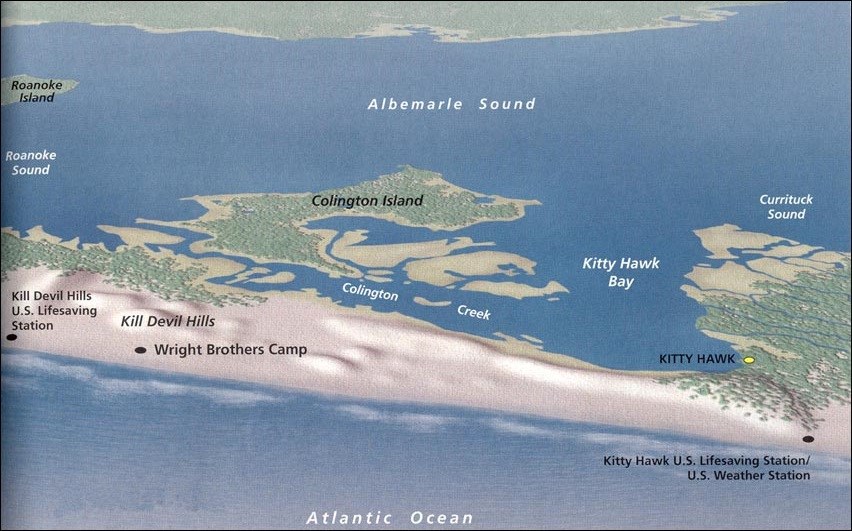
Following are excerpts from a letter the Wright brothers received in August 1900 from William (Bill) Tate, a resident of the Outer Banks:
In answering I would say that you would find here nearly any type of ground you could wish; you could, for instance, get a stretch of sandy land 1 mile by five with a bare hill in center 80 feet high, not a tree or bush anywhere to break the eveness of the wind current. This in my opinion would be a fine place; our winds are always steady, generally from 10 to 20 miles velocity per hour.…Would advise you to come any time from Sept. 15 to Oct. 15. Don't wait until Nov. The autumn generally gets a little rough by Nov.¹
The "hill" Tate referred to was part of a group of sand dunes known as the Kill Devil Hills. The largest of these was approximately 100 feet tall and served as the Wrights' primary launching site for their gliders.
Questions for Map 2
1. According to Bill Tate, what features of the Kitty Hawk area made it a suitable location for flight experiments? What warnings did he provide?
2. Match Map 2 to Map 1. What additional information does Map 2 give you about the area?
3. Locate Kitty Hawk, Kill Devil Hills, and the Wright brothers' camp on Map 2. Why do you think the Wrights established their camp where they did?
¹ William Tate to Wilbur Wright, August 18, 1900. In Fred C. Kelly, ed., Miracle at Kitty Hawk: The Letters of Wilbur and Orville Wright (New York: Farrar, Straus & Young, 1951), 25.
Determining the Facts
Reading 1: The Quest for Flight
Prior to making their own attempts at flight, Wilbur and Orville Wright carefully studied the work of others. After contacting the Smithsonian Institution in Washington, D.C., in 1899, the brothers received articles published by the Smithsonian as well as other reference materials on the status of flight experiments. Although most people agreed that human flight was more of a folly than a practical possibility, a few men had made some progress in the quest.
Otto Lilienthal, a German engineer, had attracted worldwide attention for making nearly 2,000 manned glider flights in the late 19th century. He studied the flight of birds and designed his glider's wings with a gentle curve to provide lifting power. His only means of controlling the gliders, however, was shifting his weight from side to side as he hung suspended between the wings. Although he was considered successful, his longest time in the air was only 15 seconds. He died in 1896 when his glider plummeted to the ground. Orville and Wilbur Wright read newspaper accounts of Lilienthal's death and began to discuss possible reasons for the fatal accident. Thus began the brothers' serious interest in the mechanics of flight.
In 1894, Octave Chanute, a civil engineer, published Progress in Flying Machines. This history of aviation was among the documents recommended to the Wright brothers by the Smithsonian. In 1896, Chanute had successfully tested a manned glider. Its biplane design would later influence the Wright brothers' work. Between 1896 and 1898 his assistants made hundreds of flights on windy sand dunes near Lake Michigan. The longest glide lasted 14 seconds. In a letter to Chanute dated May 1900, Wilbur Wright wrote: "For some years I have been afflicted with the belief that flight is possible to man. My disease has increased in severity and I feel it will soon cost me an increased amount of money if not my life. I have been trying to arrange my affairs in such a way that I can devote my entire time for a few months to experiment in this field."¹ Chanute and the Wrights soon became close friends and colleagues in the field of aviation.
Samuel Langley, secretary of the Smithsonian Institution, also was a well known flight experimenter in the late 19th century. The Wright brothers studied his book, Experiments in Aerodynamics. In 1896 he flew a steam-powered model called an aerodrome. It was the first large-scale, heavier-than-air machine to fly, but it had no steering capability. Langley's success led the U.S. Government to fund his effort to develop a full-size machine capable of carrying a man. The design consisted of two pairs of curved wings, one behind the other, with a steam engine in between. In the fall of 1903, he made two highly publicized attempts to launch his full-size aerodromes from the roof of a houseboat. Both trials ended in embarrassing failures. The Wrights were aware of Langley's attempts, the second of which took place just nine days before their own successful flight.
Based on what they had read, Wilbur and Orville believed that Lilienthal had been the most successful researcher and had collected the most reliable data, particularly his calculations on air pressure. Ready to attack the problem themselves, they agreed that three things were necessary for a manned machine to fly: wings to lift the machine into the air; power to propel it through the air; and a method of controlling or balancing the machine in flight rather than just hanging on for the ride. The first two had been worked out to some degree by others, but the third component proved much more difficult. Mechanisms would be required to control three kinds of motion in an aircraft: rotation of the wings from side to side (roll); up and down movement of the nose (pitch); and steering right or left (yaw). The Wright brothers' ability to recognize and scientifically solve each of these set them apart from other experimenters.
Based on observing how birds steadied themselves in flight and idly twisting a bicycle inner tube box one day, Wilbur Wright came up with the idea of twisting the kite's wing tips in opposite directions to control lateral movement (roll). In the summer of 1899 the brothers built their first experimental aircraft--a biplane kite with a five-foot wingspan and a horizontal tail for stability. The kite had cords attached to each wing tip that allowed the operator to twist or warp one set upward and the other downward. Once they had proven that their revolutionary "wing-warping" theory worked, they built a glider large enough to carry a man. Meanwhile, they attended to their bicycle business and prepared for the 1900 spring and summer season. When business slowed down in the fall, however, the brothers were ready to travel to North Carolina's remote Outer Banks and concentrate exclusively on their experiments.
Questions for Reading 1
1. Briefly describe the work of Lilienthal, Chanute, and Langley. How did each influence the Wright brothers?
2. What word did Wilbur Wright use in his letter to Chanute to refer to his interest in flight? What did this indicate about his growing passion?
3. What three things were required for a manned machine to fly? Which of these was the most difficult to work out?
4. What are the three kinds of motion that needed to be controlled in an aircraft?
5. What is wing warping? How did Wilbur Wright come up with the idea? How did the brothers first test this theory?
Reading 1 was compiled from Harry Combs, Kill Devil Hill: Discovering the Secret of the Wright Brothers (Boston: Houghton Mifflin Company, 1979); Tom D. Crouch, The Bishop's Boys: A Life of Wilbur and Orville Wright (New York: W.W. Norton & Company, 1989); Tom D. Crouch, First Flight: The Wright Brothers and the Invention of the Airplane (Harpers Ferry, WV: National Park Service Division of Publications); Russell Freedman, The Wright Brothers: How They Invented the Airplane (New York: Holiday House, 1991); and Marvin W. McFarland, ed., The Papers of Wilbur and Orville Wright, vol. 1 (New York: McGraw-Hill, 1953).
¹ Wilbur Wright to Octave Chanute, May 13, 1900. In Marvin W. McFarland, ed., The Papers of Wilbur and Orville Wright (New York: McGraw-Hill, 1953), vol. 1, 15-19.
Determining the Facts
Reading 2: From Gliding to Controlled Powered Flight
Wilbur Wright arrived in Kitty Hawk on September 13, 1900. He stayed with the family of William (Bill) Tate, the local postmaster, while he assembled the glider. When Orville arrived less then two weeks later they set up a tent near the Tate's home. The conditions that promised to be ideal for gliding were less than perfect for camping. Orville wrote to his sister in Dayton, "When one of these 45-mile nor'easters strikes us…there is little sleep in our camp….When we crawl out of the tent to fix things outside, the sand fairly blinds us. It blows across the ground in clouds. We certainly can't complain of the place. We came down here for wind and sand, and we have got them."¹
The brothers had determined the dimensions of their first machine and the curvature of the wings based on Otto Lilienthal's calculations on lifting power. The assembled aircraft was a 50-pound biplane with a 17-foot wingspan. The wooden frame was covered with French sateen. A movable horizontal rudder--called an elevator--extended in front of the wings to control up and down movements (pitch). Lying facedown on the lower wing, the pilot tilted the elevator up or down with a hand control and operated the wing-warping wires with his feet. Testing the glider as a kite showed that the wing warping balanced the machine, but the elevator's response was not consistent, and the wings did not produce the expected lift.
Anxious to attempt manned glides, the brothers and Bill Tate hauled the glider four miles south of Kitty Hawk to a group of tall sand dunes known as the Kill Devil Hills. They dragged it part way up the tallest hill (which the Wright brothers called Big Hill) where Wilbur got into position as the pilot. Orville and Bill Tate grabbed the wing tips and ran down the hill until the glider was in the air on its own. Wilbur made a dozen glides each lasting less than 20 seconds and covering a maximum distance of about 400 feet. Wilbur wrote, "We were very much pleased with the general results of the trip, for setting out as we did, with almost revolutionary theories…and an entirely untried form of machine, we considered it quite a point to be able to return without having our pet theories completely knocked in the head…and our brains dashed out in the bargain."² The brothers left the Outer Banks on October 19, 1900, to return to Dayton. They set to work designing an improved glider that would hopefully solve the problems encountered during the first season.
The 1901 glider had a 22-foot wingspan, now covered with cotton fabric, and weighed almost 100 pounds. Instead of using a foot control, the pilot now moved the wing-warping wires by shifting his hips in a hip cradle. Not wanting to wait until fall to test the new glider, the brothers hired mechanic Charlie Taylor to take care of the bike shop. They arrived on the Outer Banks in July and established a camp at the base of the Kill Devil Hills to be closer to their launching site. They set up a tent for themselves, and built a wooden shed or hangar to store the glider. Barely settled in, they endured a week of torrential rain followed by a terrible outbreak of mosquitoes. Orville complained, "There was no escape. Everything was fairly covered with them. They chewed us clear through our underwear and socks."³
They conducted up to 100 glides from July 27 to August 17, but there were several problems from the beginning. The glider's wings still did not produce enough lift, and the elevator was not always reliable. They also experienced frightening problems with the wing-warping system that caused the pilot to lose control of the glider unexpectedly. The rain returned, and they went back to Dayton with their spirits dampened. Wilbur later wrote, "When we looked at the time and money we had expended, and considered the progress made and the distance yet to go, we considered our experiments a failure."4
Rather than give up, the brothers worked to solve the problems of the 1901 season. Convinced now that Lilienthal's lift tables were incorrect, they designed a small wind tunnel inside the cycle shop to gather their own data. After testing wing shapes inside the wood and metal tunnel, they realized that a longer, narrower wing would perform better. During the winter and spring of 1902 they built a new 120-pound glider with a 32-foot wingspan. The glider now featured a fixed, vertical rudder extending several feet to the rear, which they hoped would address the wing-warping problem by controlling yaw.
Arriving on the Outer Banks on August 28, 1902, Wilbur and Orville made repairs to the shed and enlarged it to provide living quarters. By October 24, the brothers had completed several hundred glides from the Kill Devil Hills. Although the glider was much improved, it still behaved unpredictably at times. To solve the problem, the brothers made the rudder movable and connected it to the wing-warping wires so that it automatically turned in the proper direction. The 1902 machine now was a great success, making glides of more than 600 feet in 26 seconds. The Wrights had at last designed and flown a machine that could be fully controlled by a pilot. In a letter to his sister, Orville excitedly exclaimed, "We now hold all the records! …the longest distance glide, the longest time in the air, the smallest angle of descent, and the highest wind!!!"5 The brothers left at the end of October eager to take the next step-adding an engine and propellers to create a powered flying machine.
Back home in Dayton, the brothers, assisted by their bicycle shop mechanic Charlie Taylor, had to build a suitable gasoline engine themselves. The completed cast aluminum, four-cylinder engine weighed approximately 200 pounds. Designing propellers turned out to be even more difficult because nothing similar was in use. With their wind tunnel data, they decided to construct two 8 ½ foot-long propellers that turned in opposite directions. The propellers were linked to the motor, which was placed on the lower wing to the right of the pilot, by a chain-drive transmission similar to a bike. The "Flyer," as they called the machine, had a wingspan of 40 feet and weighed 605 pounds.
When they arrived back at camp on September 26, 1903, the brothers had to repair the building, which had been blown from its foundation during winter storms. They erected a second building to house the Flyer and used the original building as living quarters and workshop. By the beginning of November, the Flyer was almost put together and engine testing was underway. One test damaged the propeller shafts, which had to be sent back to Dayton for repairs.
Once the shafts were repaired and returned, they soon failed again. Continuing problems forced Orville to go to Dayton himself to make new ones. He did not return to the Outer Banks until December 11. They had already endured periods of extreme winds, rain, and bitter temperatures and were anxious to try the machine before the weather got even worse. On December 14, they attempted to launch the Flyer from the gentle lower slope of the hill because the wind was not sufficient to take off from level ground. Unfortunately, this first attempt failed when Wilbur lifted the airplane at too sharp an angle, which caused an immediate stall and damaged the elevator in the resulting hard landing.
On the morning of December 17, with temperatures near freezing and winds between 20 and 27 mph, the Wright brothers were ready to try again. Three men from the lifesaving station and two other locals arrived to help. They laid out the sections of a 60-foot wooden launching track on flat ground about 100 feet west of their camp, and Orville took his place as pilot. The airplane traveled along the launching rail on a wheeled dolly or truck, rose into the air, and landed in the sand after an unsteady, 12-second, 120-foot flight. Wilbur made the second flight which covered 175 feet in 12 seconds. Then Orville flew 200 feet in 15 seconds. At 12:00 p.m., Wilbur flew 852 feet and stayed airborne for 59 seconds at an altitude of between 8 and 12 feet before the airplane landed and sustained minor damage. The group had returned to the camp for a break when a sudden gust of wind toppled the airplane and damaged it beyond repair. The 1903 Flyer would never fly again, but it had effectively launched the age of human flight and secured the Wright brothers' place in history.
Questions for Reading 2
1. What problems did the brothers encounter during their experiments each season on the Outer Banks? How did they attempt to solve these problems? What did this indicate about their perseverance as well as their skill as inventors?
2. When did Wilbur and Orville begin the 1901 season? What did this indicate about their enthusiasm and priorities at the time?
3. Where did the Wright brothers live during each of the four seasons on the Outer Banks? What were some of the conditions they endured during their stays?
4. Create a chart that shows the characteristics (wingspan, weight, physical features) of each of the Wrights' flying machines. Based on the chart, how did the machines evolve from 1900 to 1903?
5. What was the distance and time of each flight on December 17, 1903? Why didn't they make more flights that day?
Reading 2 was compiled from Harry Combs, Kill Devil Hill: Discovering the Secret of the Wright Brothers (Boston: Houghton Mifflin Company, 1979); Tom D. Crouch, The Bishop's Boys: A Life of Wilbur and Orville Wright (New York: W.W. Norton & Company, 1989); Tom D. Crouch, First Flight: The Wright Brothers and the Invention of the Airplane (Harpers Ferry, WV: National Park Service Division of Publications); Russell Freedman, The Wright Brothers: How They Invented the Airplane (New York: Holiday House, 1991); Fred C. Kelly, The Wright Brothers: A Biography (1943; reprint, New York: Dover Publications, Inc., 1989); Marvin W. McFarland, ed., The Papers of Wilbur and Orville Wright, vol. 1 (New York: McGraw-Hill, 1953); and Orville Wright, How We Invented the Airplane: An Illustrated History, ed. Fred C. Kelly (1953; reprint, New York: Dover Publications, Inc., 1988).
¹ Orville Wright to Katherine Wright, October 18, 1900. In Marvin W. McFarland, ed., The Papers of Wilbur and Orville Wright (New York: McGraw-Hill, 1953), vol. 1, 37.
² As quoted in Russell Freedman, The Wright Brothers: How They Invented the Airplane (New York: Holiday House, 1991), 38.
³ Orville Wright to Katherine Wright, July 28, 1901. In Marvin W. McFarland, ed., The Papers of Wilbur and Orville Wright (New York: McGraw-Hill, 1953), vol. 1, 73.
4 As quoted in Harry Combs, Kill Devil Hill: Discovering the Secret of the Wright Brothers (Boston: Houghton Mifflin Company, 1979), 147.
5 Ibid., 173.
Determining the Facts
Document 1: Excerpt from Orville Wright's Diary, December 17, 1903
When we got up a wind of between 20 and 25 miles was blowing from the north. We got the machine out early and put out the signal for the men at the station. Before we were quite ready, John T. Daniels, W.S. Dough, A.D. Etheridge, W.C. Brinkley of Manteo, and Johnny Moore of Nags Head arrived. After running the engine and propellers a few minutes to get them in working order, I got on the machine at 10:35 for the first trial. The wind, according to our anemometers at this time, was blowing a little over 20 miles (corrected) 27 according to the Government anemometer at Kitty Hawk. On slipping the rope the machine started off increasing in speed to probably 7 or 8 miles. The machine lifted from the truck just as it was entering on the fourth rail. Mr. Daniels took a picture just as it left the tracks. I found the control of the front rudder quite difficult on account of its being balanced too near the center and thus had a tendency to turn itself when started so that the rudder was turned too far on one side and then too far on the other. As a result the machine would rise suddenly to about 10 ft. and then as suddenly, on turning the rudder, dart for the ground. A sudden dart when out about 100 feet from the end of the tracks ended the flight.
Questions for Document 1
1. What new details does Orville's diary account give you about the first flight? What problems did he encounter?
2. How would you describe the language Orville used in his diary? Is it what you would have expected considering the significance of the event? Explain your answer.
3. Based on the context of the quote, what is an anemometer? Why would this instrument have been important to the Wright brothers?
4. The Wrights meticulously recorded their experiences both in writings and photographs. Why would this be important both to their contemporaries and to historians and scientists today?
Document 1 courtesy of the Library of Congress, Wilbur and Orville Wright Collection.
Determining the Facts
Reading 3: The Wright Brothers' Legacy
On the afternoon of December 17, 1903, Wilbur and Orville Wright walked four miles to Kitty Hawk to send the following telegram to their father in Dayton: "Success four flights Thursday morning all against twenty one mile wind started from level with engine power alone average speed through air thirty one miles longest 57 [sic] seconds inform press home Christmas." After returning to Dayton, the brothers issued their own press statement: "We should have postponed our trials to a more favorable season, but…we were determined…to know whether the machine possessed sufficient capacity of control to make flight safe in boisterous winds, as well as in calm air. When these points had been definitely established, we at once packed our goods and returned home, knowing that the age of the flying machine had come at last."¹ Due to a combination of wildly inaccurate accounts and lack of understanding by most newspaper publishers, however, the true significance of December 17, 1903, escaped all but a few people.
During the winter and spring of 1904, the Wright brothers began constructing an improved version of their airplane. Although they had made the world's first controlled powered flight they would need to make several changes before their machine could be considered a practical airplane. They continued their experiments close to home so they could remain near their bicycle shop and lengthen their flying season. Huffman Prairie, an 84-acre pasture about eight miles from their home, became their new testing ground. On October 5, 1905, after many months of frustrating trials, they flew the third version of their airplane almost 25 miles in 39 minutes. Wilbur and Orville Wright had at last invented the world's first practical flying machine.
Next came the challenge of keeping others from copying their airplane design while at the same time trying to secure contracts for its sale. They tried to interest the U.S. Government and some European governments in buying the rights to their airplane, but had little luck. In order to protect the details of their invention before it was patented or sold, they did not fly for more than two years. Finally, a French company signed a contract to build and sell Wright airplanes in early 1908. The U.S. Army Signal Corps also expressed interest in the Wright Flyer, but only if it could meet specific requirements. Both contracts were contingent on successful demonstrations. Wilbur dazzled crowds in France, and Orville likewise made several stunning flights at Fort Myer, Virginia. After enduring several years of public skepticism, the Wright brothers finally achieved widespread recognition of their accomplishments.
Now treated as heroes, Wilbur and Orville Wright continued to set new records in distance and duration in front of amazed crowds. By this time they had closed the bike shop to devote all of their time to aviation. In 1909 they formed the Wright Company to build and sell airplanes as well as train pilots. Unfortunately, they also spent much of their time fighting legal battles over infringements to the patent they finally had received in 1906. Then, in 1912, the unique partnership that had led to the invention of the airplane--a feat mankind dreamed about for thousands of years--ended abruptly when Wilbur died of typhoid fever at age 45.
In the 1920s, an effort began to properly acknowledge Wilbur and Orville Wright's accomplishments in aviation. A group of North Carolinians organized the Kill Devil Hills Memorial Association to recognize and help protect the site of the Wright brothers' experiments on the Outer Banks. National figures joined local efforts to create a monument honoring the Wrights, and on March 2, 1927, President Calvin Coolidge established the Kill Devil Hill Monument National Memorial.
In the intervening 25 years, remnants of the brothers' camp buildings had all but disappeared, and the Big Kill Devil Hill sand dune had shifted several hundred feet due to high winds. Two decades of shifting sands also made it difficult to locate the exact spot where the 1903 Flyer took off. Three of the four surviving witnesses to the first flight gathered at the Kill Devil Hills area and, using Orville Wright's written accounts, located the approximate site of the liftoff. On December 17, 1928, Orville Wright watched as representatives from the National Aeronautics Association placed a six-foot granite marker at the site.
Before a monument could be constructed atop Big Kill Devil Hill, it would have to be stabilized with shrubs and plantings to prevent further shifting. The government and local citizens undertook the effort, and by 1930 Big Kill Devil Hill was covered in grass and shrubs. The New York architectural firm of Rodgers and Poor won the design competition for the monument. Their design called for a 60-foot masonry shaft resting on a star-shaped platform. Stylized sculpted wings on each side would symbolize flight and motion. Work began in December 1931 and was completed, with the help of many local citizens, by the end of the following year. In 1933 administration of the site passed from the War Department to the National Park Service. Renamed Wright Brothers National Memorial in 1953, the park today includes the monument on Big Kill Devil Hill, the granite marker at the liftoff spot, four smaller granite markers designating the landing spot of each of the four flights, and reconstructed 1903 camp buildings. A visitor center and Centennial pavilion house reproductions of the 1902 glider and 1903 Flyer, as well as other exhibits.
Questions for Reading 3
1. Why didn't the Wright brothers' accomplishment on December 17, 1903, receive the publicity it deserved?
2. Why did the Wrights build another plane after the 1903 Flyer? Why did they decide to conduct future tests in Dayton? Where did these tests take place?
3. When did they invent the first practical airplane?
4. Why did the Wrights stop flying for more than two years? Why and when did they finally resume flying? What was the result?
5. When did efforts begin to commemorate the brothers' work? What challenges had to be overcome?
6. How is the site commemorated today?
Reading 3 was compiled from William R. Chapman and Jill K. Hanson, Wright Brothers National Memorial Historic Resource Study (Atlanta, GA: Southeast Field Area, National Park Service, 1997); Harry Combs, Kill Devil Hill: Discovering the Secret of the Wright Brothers (Boston: Houghton Mifflin Company, 1979); Tom D. Crouch, The Bishop's Boys: A Life of Wilbur and Orville Wright (New York: W.W. Norton & Company, 1989); Tom D. Crouch, First Flight: The Wright Brothers and the Invention of the Airplane (Harpers Ferry, WV: National Park Service Division of Publications); Russell Freedman, The Wright Brothers: How They Invented the Airplane (New York: Holiday House, 1991); Susan Hitchcock, Wright Brothers National Memorial Cultural Landscape Report (Atlanta, GA: Southeast Field Area, National Park Service, 2002).
¹ As quoted in Russell Freedman, The Wright Brothers: How They Invented the Airplane (New York: Holiday House, 1991), 81.
Visual Evidence
Photo 1: Wilbur Wright flying the 1901 glider.
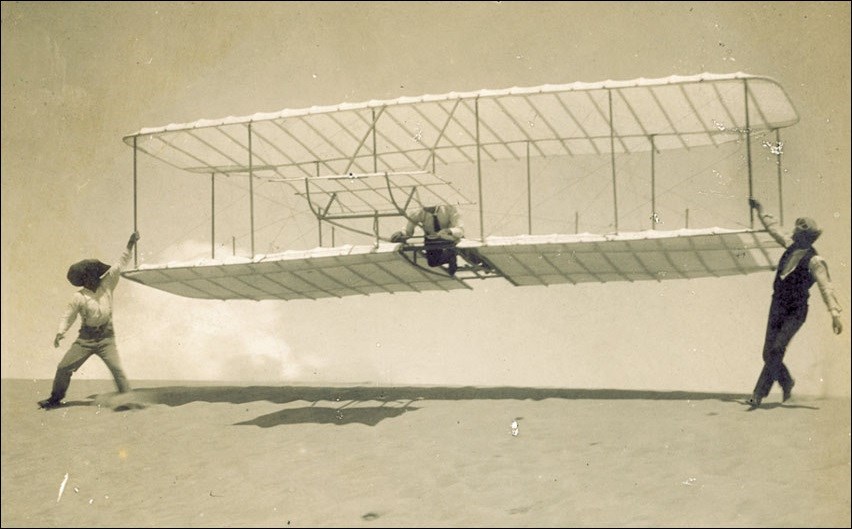
Photo 2: Orville Wright flying the 1902 glider.
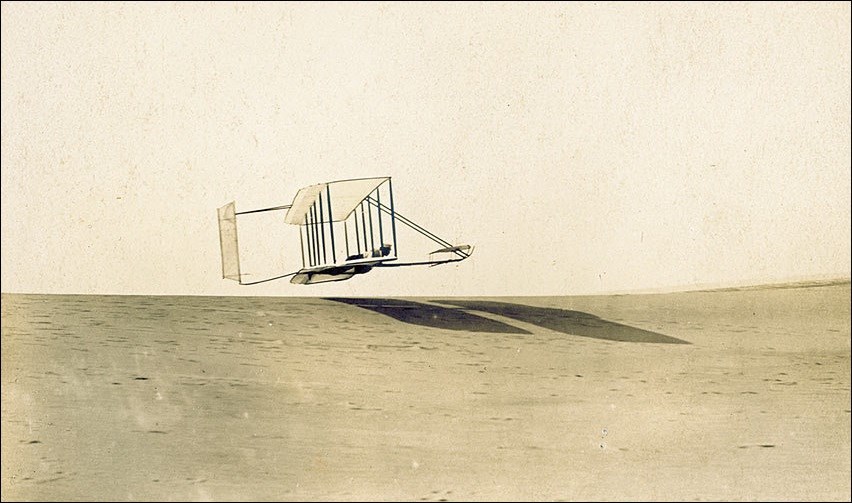
In Photo 1, Dan Tate (Bill Tate's brother) and a visitor to the Wrights' camp (right) help launch the 1901 glider.
Questions for Photos 1 and 2
1. How were the gliders launched?
2. What parts of each glider can you identify?
3. Based on the photos and Reading 2, what new feature was added to the glider in 1902? What was it designed to accomplish?
4. Does examining these photos of the gliders help you to better understand the Wright brothers' experiments? If so, how?
Visual Evidence
Photo 3: Interior of the Wright brothers' shed/living quarters, 1902.
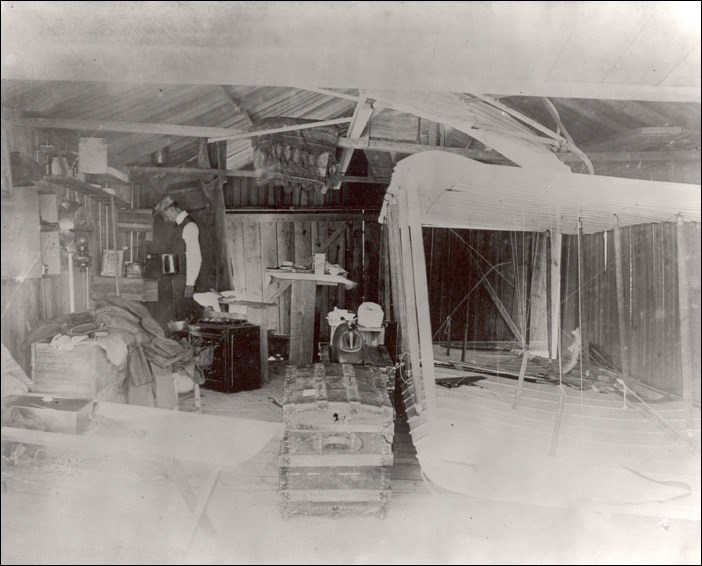
In 1902, Wilbur Wright wrote to his friend George Spratt, "We fitted up our living arrangements much more comfortably than last year. Our kitchen is immensely improved, and then we have made beds on the second floor and now sleep aloft. It is an improvement over cots. We have put battens on the cracks of the whole building including the addition, so it is much tighter and waterproof than before as well as more sandproof…."¹
Questions for Photo 3
1. What can you determine about the Wright brothers' living conditions at the time this photo was taken? What does Wilbur Wright's quote indicate about earlier conditions?
2. What things can you identify in the photo? What do you think is pictured at the right of the photo?
3. Do you think you would have been willing to endure similar conditions year after year without knowing if your experiments would ever be successful? Explain your answer.
¹ Wilbur Wright to George Spratt, September 16, 1902. In Harry Combs, Kill Devil Hill: Discovering the Secret of the Wright Brothers (Boston: Houghton Mifflin Company, 1979), 159.
Visual Evidence
Photo 4: The Wright brothers' camp and Flyer, 1903.

Photo 4 shows the camp as it appeared in 1903 with the 48'X16' shed or hangar on the left and the Wright brothers' 42'X16' living quarters on the right.
Questions for Photo 4
1. What does the photo reveal about the landscape of the Outer Banks? What does it reveal about the Wright brothers' living conditions?
2. Based on the photo and Reading 2, what improvements did the Wright brothers make to their camp for the 1903 season?
3. What clues would help you determine which year the photo was taken if you didn't already know?
Visual Evidence
Photo 5: Liftoff on December 17, 1903.

Before climbing onto the plane on the morning of December 17, 1903, Orville Wright carefully set up his camera and asked John Daniels, one of the lifesavers, to snap the shutter just as the Flyer left the ground. Orville wrote, "This flight lasted only 12 seconds, but it was nevertheless the first in the history of the world in which a machine carrying a man had raised itself by its own power into the air in full flight, had sailed forward without reduction of speed, and had finally landed at a point as high as that from which it had started."¹
Questions for Photo 5
1. Why do you think Orville Wright set up his camera for this occasion? What does it tell you about his expectations for that day? Who took the photo?
2. What do you think is the significance of capturing this moment on film (to people of the time period and today)?
3. Based on Photo 5 and Reading 2, how was the Flyer launched? Based on Orville's quote, why was it important to launch the plane from level ground?
4. What parts of the Flyer can you identify in this photo? What made the Flyer different from the gliders?
¹As quoted in Russell Freedman, The Wright Brothers: How They Invented the Airplane (New York: Holiday House, 1991), 76.
Visual Evidence
Photo 6: First Flight markers today.
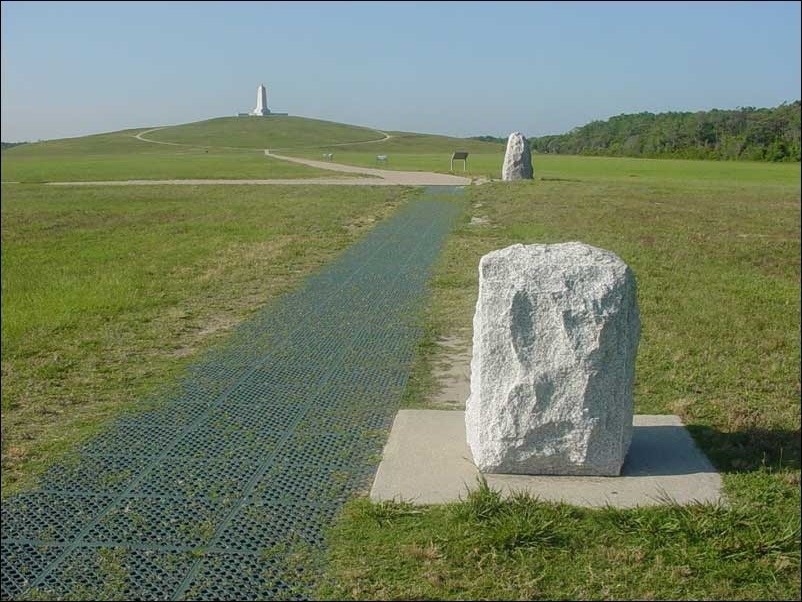
Photo 7: Wright brothers' monument today.
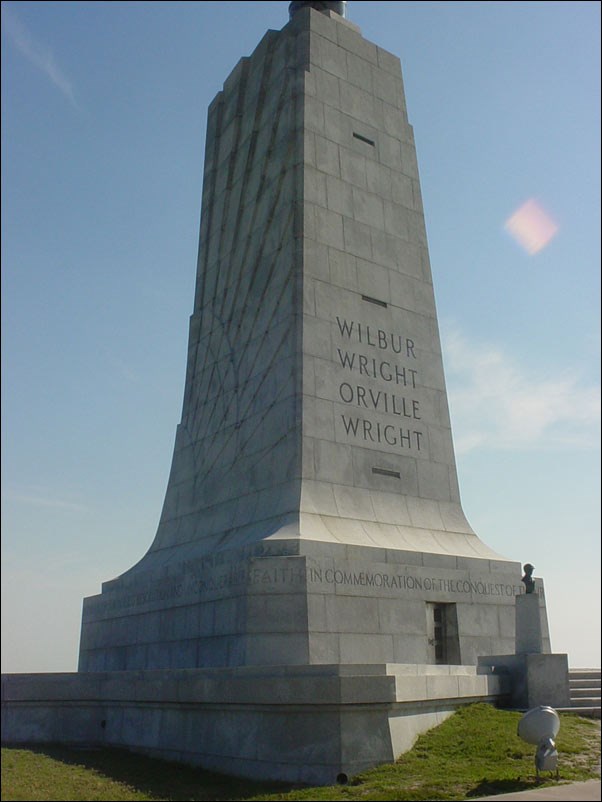
The large granite boulder in the right background of Photo 6 designates the approximate takeoff spot of the first flight on December 17, 1903. The marker in the right foreground designates the approximate landing spot of that first 120-foot flight. The Wright brothers' monument atop Big Kill Devil Hill is visible in the distance.
Photo 7 shows the Wright brothers' monument today. The inscription along the base of the monument reads:
In Commemoration of the Conquest of the Air
By the Brothers Wilbur and Orville Wright
Conceived By Genius
Achieved by Dauntless Resolution and Unconquerable Faith
Questions for Photos 6 & 7
1. Windy and sandy conditions brought the Wright brothers to the Outer Banks in the first place. According to Reading 3, what impact did these conditions have on the site in the years after their experiments?
2. Based on information in Reading 3, how accurate do you think the placement of the marker stones might be? Do you think they contribute to our understanding of what the Wright brothers accomplished at this site? Explain your answer.
3. Do you agree or disagree with the decision to stabilize Big Kill Devil Hill sand dune with grass and plantings to prevent it from further shifting? Explain your answer.
4. Do you think the memorial's design is an appropriate tribute to the Wright brothers? Why or why not?
Putting It All Together
In this lesson, students discover why the Wright Brothers chose the Outer Banks of North Carolina to conduct their flight experiments, how they achieved controlled powered flight in 1903, and how their accomplishments have been commemorated. The following activities will help them apply what they have learned.
Activity 1: The Impact of Airplanes
Remind students that even though we take for granted the ability to fly anywhere in the world today, human flight is a very recent development in our history. Divide students into four groups and ask each group to research the role of airplanes in one of the following categories: World War I, World War II, Commerce and Industry, or Passenger Transportation during the first half of the 20th century. Ask each group to present their findings in an oral or written report, and then hold a classroom discussion on the worldwide impact of the Wright brothers' accomplishments.
Activity 2: Honoring Achievements in the Local Community
Explain to students that local citizens of the Outer Banks were the driving force behind the erection of the monument honoring the Wright brothers' achievements. Without local community support the Wright brothers' work might not have the same level of recognition and status that it does today. Working in groups, have students research a local effort to commemorate an important person or event in their own community. They should consider the following in their research: Who/what is the person/event being honored? How did the person/event impact the community? How is the person/event memorialized (commemorative plaque, building name, statue, museum exhibit, etc.)? Who spearheaded the commemorative effort? Did it receive widespread local support? What kind of publicity did the commemoration receive? Is the monument or memorial still important to the community today? How can you tell? Ask students to design an exhibit to present their group's findings and post all the exhibits for others to see.
Wright Brothers National Memorial: Site of the First Controlled Powered Flight--
Supplementary Resources
By studying Wright Brothers National Memorial: Site of the First Controlled Powered Flight students discover why the Wright Brothers chose the Outer Banks of North Carolina to conduct their flight experiments, how they achieved controlled powered flight in 1903, and how their accomplishments have been commemorated. Those interested in learning more will find that the Internet offers a variety of interesting materials.
Wright Brothers National Memorial
The Wright Brothers National Memorial web pages include information on visiting the park as well as detailed descriptions and visuals of the Wright brothers' work. Also helpful are links to several websites on the Wright brothers and aviation history.
Dayton Aviation Heritage National Historical Park
A cooperative effort between the National Park Service and four partners, this park includes four separate sites: The Wright Cycle Company Complex which includes the Wright-Dunbar Interpretive Center and Aviation Trail Visitor Center and Museum, as well as The Wright Cycle Company building; The Huffman Prairie Flying Field and Interpretive Center; The John W. Berry, Sr. Wright Brothers Aviation Center at Carillon Historical Park, which includes the 1905 Wright Flyer III; and The Paul Laurence Dunbar State Memorial. See the park's website for more information.
National Air and Space Museum
The Smithsonian Institution's National Air and Space Museum maintains the largest collection of historic air and space craft in the world. The original 1903 Wright Flyer is among the hundreds of artifacts on display at the museum.
Library of Congress: Wright Brothers Negatives
The Library of Congress houses more than 300 glass plate negatives taken mostly by the Wright brothers themselves between 1896 and 1911. This digitized collection provides an excellent pictorial record of the Wright brothers' experiments as well as their personal lives. Search the Prints and Photographs Online Catalog for the Wright Brothers Negatives Collection.
NASA Glenn Research Center
Managed by the Office of Educational Programs at NASA Glenn Research Center, the website Re-Living the Wright Way includes an overview of the Wright brothers' invention process, extensive information and diagrams on the Wright's gliders and Flyers, biographies of Wilbur and Orville Wright, and links to NASA lesson plans and activities.
United States Air Force Museum
The USAF Museum (USAFM) portrays the history and traditions of the United States Air Force through displays and exhibition of historical items. Check out the museum's website.
The Federal Aviation Administration--Aviation Education Outreach
The Federal Aviation Administration's Aviation Education Outreach website offers several resources for teachers.
Tags
- ohio
- ohio history
- north carolina
- north carolina history
- first flight
- wright brothers
- wright brothers national monument
- innovators
- first flights
- teaching with historic places
- twhp
- national register of historic places
- nrhp listing
- science
- early 20th century
- aviation
- aviation history
- science and technology
- twhplp
